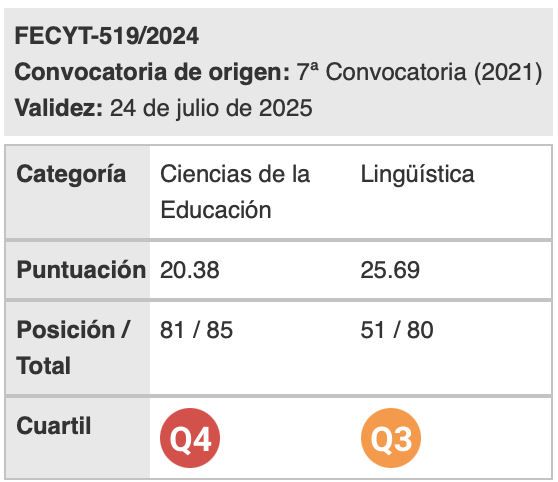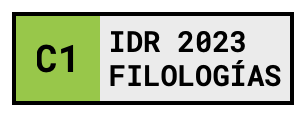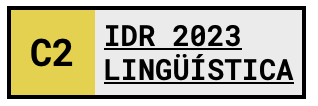Estudio para la validación de dos instrumentos para la evaluación de sitios web de aprendizaje de lenguas extranjeras
Palabras clave:
aprendizaje de segundas lenguas, competencia digital, competencia lingüística, evaluación de webs, validación instrumento de análisisResumen
El aprendizaje de lenguas, tal y como hoy lo conocemos, ha experimentado un giro copernicano que, entre otros motivos, encuentra sus raíces en una revolución tecnológica sin precedentes, la creación de contextos comunicativos reales, la motivación y la necesidad del alumnado por conocer nuevas lenguas, y la ubicuidad del aprendizaje. Estos factores hacen que la unión de la competencia lingüística y la digital se haya convertido en un constructo cardinal del proceso de aprendizaje que los habilita para acceder a herramientas, plataformas y entornos online.El proyecto de investigación titulado “LinguApp: Asegurando el acceso al aprendizaje universal e inclusivo de segundas lenguas” (PRY208/17), financiado por la Fundación Pública Andaluza Centro de Estudios Andaluces (Consejería de la Presidencia, Administración Local y Memoria Democrática de la Junta de Andalucía), planificó el desarrollo y la validación de dos instrumentos destinados a la evaluación de sitios web de aprendizaje de lenguas extranjeras. El primero de ellos valora las características técnicas de los recursos, mientras que el segundo instrumento aborda de manera específica qué destrezas y cómo se desarrollan, atendiendo a los contenidos y a las actividades que ofrece el sitio web. Este trabajo presenta los resultados estadísticos de este proceso de diseño y validación, concluyendo que este tipo de herramientas puede contribuir decididamente al desarrollo de la investigación de esta área, donde la tecnología ha modificado sustancialmente el proceso de aprendizaje y enseñanza de segundas lenguas.
Descargas
Citas
Barnes, S. y R. Vidgen (2002). An integrative approach to the assessment of e-commerce quality. Journal of Electronic Commerce Research, 3(3), 114-127.
Bass, B. M. (1983). Organizational decision making, Homewood, IL: Irwin.
Centro Virtual Cervantes (CVC). (2018). Diccionario de términos clave de ELE. <http://bit.ly/2OOoZEq> [17/08/2018].
Chen, W., Chia, G., Looi, C.K., Nooris, C., Soloway, E. y Zhang, B. (2011). 1:1 mobile inquiry learning experience for primary science students: a study of learning effectiveness. Journal of Computer Assisted Learning, 27(3), 269-287.
Cronbach, L.J. (1990). Essentials of psychological testing (5th ed.). New York: Harper Collins Publishers.
Davies, G. y Steel, D. (1981). First steps in Computer-Assisted Language Learning at Ealing College of Higher Education. <http://www.ict4lt.org/en/DaviesSteel1981.doc.> [16/08/2018].
Erbaggio, P., Gopalakrishnan, S., Hobbs, S. y Liu, H. (2012). Enhancing student engagement through online authentic materials. IALLT Journal of Language Learning Technologies, 42(2), 27–51.
Eshet-Alkali, Y. y Amichai-Hamburger, Y. (2004). Experiments in digital literacy. Cyberpsychology and Behavior, 7, 421–429.
Ganderton, R. (1998). New strategies for a new medium? Observing L2 reading on the world wide web. On-Call, 12(2), 2–9.
Ghareb, M.I., Sate-Askew, S. y Mohammed, S.A. (2018). Applying the New Paradigm of Anywhere Any Time in ESL Teaching Experience in the KRG Province Iraq. International Journal of Scientific & Technology Research, 7(5), 211-219.
Hafner, C.A., Chik, A. y Jones, R.H. (2015). Digital literacies and language learning. Language Learning & Technology, 19(3), 1-7. <http://llt.msu.edu/issues/october2015/commentary.pdf> [16/08/2018].
Hatlevik, O. E. y Christophersen, K.-A. (2013). Digital competence at the beginning of upper secondary school: Identifying factors explaining digital inclusion. Computers & Education, 63, 240–247.
Huizenga, J., Admiraal, W., Akkerman, S. y Dam, G.t. (2009). Mobile game-based learning in secondary education: engagement, motivation and learning in a mobile city game. Journal of Computer Assisted Learning, 25(4), 332-344.
Hung H-L., Altschuld, J.W. & Lee, Y. (2008). Methodological and conceptual issues confronting a cross-country Delphi study of educational program evaluation. Evaluation and Program Planning, 31, 191–198.
Hwang, G.J. y Tsai, C.C. (2011). Research trends in mobile and ubiquitous learning: a review of publications in selected journals from 2001 to 2010. British Journal of Educational Technology, 42(4), 65-70.
Hwang, W. Y., Chen, H. S., Shadiev, R., Huang, R. Y. M. y Chen, C. Y. (2014). Improving English as a foreign language writing in elementary schools using mobile devices in familiar situational contexts. Computer Assisted Language Learning, 27(5), 359-378. doi: 10.1080/09588221.2012.733711.
IEEE Std 1061, (1992). IEEE Standard for a Software Quality Metrics Methodology. IEEE Computer Society Press.
ISO/IEC 14598-5, (1998). International Standard: Information technology - Software product evaluation - Part 5: Process for evaluators. International Electrotechnical Commission.
ISO/IEC 9126, (1991). International Standard: Information technology - Software product evaluation - Quality characteristics and guidelines for their use. International Electrotechnical Commission.
Jakobson, R. (1985). Metalanguage as a Linguistic Problem. En S.R. Mouton (Ed.), Selected Writings, VII (pp. 113-121). <https://bit.ly/2MsNNEl> [16/08/2018].
Johnson, K. (2018). An Introduction to Foreign Language Learning and Teaching (Revised Third Edition). London: Routledge.
Johnson, S. (Ed.) (2012). Key issues for e-resource collection development: a guide for libraries. International Federation of Library Associations and Institutions (IFLA). < https://bit.ly/2RjIuWI> [24/10/2018].
Kern, R. (2015). Language, literacy, and technology. Cambridge: Cambridge University Press.
Kim, H. y Kwon, Y. (2012). Exploring smartphone applications for effective mobile-assisted language learning. Multimedia-Assisted Language Learning, 15(1), 31-57.
Kumaravadivelu, R. (1994). La situación posmétodo: estrategias emergentes y confluyentes para la enseñanza de segundas lenguas y de lenguas extranjeras. Antologías de textos de didáctica del español. <https://bit.ly/2BjN8k5> [17/08/2018].
Landeta, J. (2006). Current validity of the Delphi method in social sciences. Technological forecasting and social change, 73(5), 467-482.
Lee, K.W. (2000). English teachers’ barriers to the use of computer-assisted language learning. The Internet TESL Journal, 6(12), 1-8. doi: 10.1002/tesq.304.
Levy, M. (1997). CALL: Context and Conceptualisation. Oxford: Oxford University Press.
Levy-Magin, J.P. y Varela-Mallou, J. (2003). Análisis Multivariable para las Ciencias Sociales. Madrid: Pearson Prentice Hall.
Ludwig, B. G. (1997). Predicting the future: Have you considered using the Delphi methodology? Journal of Extension (electronic version), 35(5).
Mengual, S. (2011). La importancia percibida por el profesorado y el alumnado sobre la inclusión de la competencia digital en educación Superior. Alicante: Departamento de Didáctica General y Didácticas específicas de la Facultad de Alicante.
Nunnally, J. C. y Bernstein, I. H. (1994) Psychometric theory (3rd ed.). New York, NY: McGraw-Hill, Inc.
Núñez, M. (2002). Criterios para la evaluación de la calidad de las fuentes de información sobre salud en Internet. ACIMED, 10(5), 9-10. <https://bit.ly/2yzM1ck> [22/10/2018].
Pareja-Lora, A., Arús, J., Martín-Monje, E., Read, T., Pomposo-Yanes, L., Rodríguez-Arancón, P., ... Bárcena, E. (2013). Toward mobile assisted language learning apps for professionals that integrate learning into the daily routine. En L. Bradley y S. Thouësny (Eds.), 20 years of EUROCALL: Learning from the past, looking to the future. Proceedings of EUROCALL 2013 EUROCALL Conference, Évora, Portugal (pp. 206-210). Dublin: Research Publishing.
Parlamento Europeo y Consejo de la Unión Europea. (2006). Recomendación del Parlamento Europeo y del Consejo de 18 de diciembre de 2006 sobre las competencias clave para el aprendizaje permanente (2006/962/CE). Diario Oficial de la Unión Europea, L 394/10. <http://bit.ly/2wf0WH1> [20/08/2018].
Rivero, I. (2013). Criterios para seleccionar tecnologías educativas y estrategias didácticas en el Colegio Guillermo León Valencia. Educación y ciencia, 16, 37-52.
Román, E. (2002). Web-based Instructional Environments: Tools and Techniques for Effective Second Language Acquisition. International Journal of English Studies, 2(1), 31-58.
Rosell-Aguilar, F. (2018). Autonomous language learning through a mobile application: a user evaluation of the busuu app. Computer Assisted Language Learning, 2018, 1-28. doi: 10.1080/09588221.2018.1456465.
Savignon, S.J. (1991). Communicative language teaching: State of the art. TESOL Quarterly, 25(2), 261-278.
Sufeng, Y., Runjuan, S. y Liming, S. (2011). Computer-Assisted Language Learning in Higher Education. 2011 IEEE International Symposium on IT in Medicine and Education, Cuangzhou (pp. 137-141). doi: 10.1109/ITiME.2011.6130802.
Tafazoli, D., Gómez, M.E. y Huertas, C. A. (2018). Preface. En D. Tafazoli, M.E. Gómez y C. A. Huertas (Eds.), Cross-Cultural Perspectives on Technology-Enhanced Language Learning (pp. xx-xxvii). Hershey, PA: IGI Global.
Widdowson, H.G. (2004). Skills and knowledge in language learning. En M. Byram (Ed.), Routledge Encyclopedia of Language Teaching and Learning (pp. 548-553). Abingdon: Routledge.
Descargas
Publicado
Cómo citar
Número
Sección
Licencia
Aquellos autores/as que tengan publicaciones con esta revista, aceptan los términos siguientes:
- Los autores/as conservarán sus derechos de autor y garantizarán a la revista el derecho de primera publicación de su obra, el cuál estará simultáneamente sujeto a la Licencia de reconocimiento de Creative Commons que permite a terceros compartir la obra siempre que se indique su autor y su primera publicación esta revista.
- Los autores/as podrán adoptar otros acuerdos de licencia no exclusiva de distribución de la versión de la obra publicada (p. ej.: depositarla en un archivo telemático institucional o publicarla en un volumen monográfico) siempre que se indique la publicación inicial en esta revista.
- Se permite y recomienda a los autores/as difundir su obra a través de Internet (p. ej.: en archivos telemáticos institucionales o en su página web) antes y durante el proceso de envío, lo cual puede producir intercambios interesantes y aumentar las citas de la obra publicada. (Véase El efecto del acceso abierto).

Revista de Lenguas para fines específicos is licensed under a Creative Commons Reconocimiento-NoComercial-SinObraDerivada 4.0 Internacional License.























